Abstract
Female virgin mice, whose submandibular glands were removed, underwent normal pregnancy and delivery. During the nursing period, however, a substantial number of pups born to and nursed by sialoadenectomized mothers died within 5 days of birth, whereas this did not occur among pups born to normal mothers. Cross-foster nursing experiments indicated that the cause of death of pups was to be found in sialoadenectomized mothers, not in the pups. The capacity of the sialoadenectomized mothers to nurse pups was much less than that of normal mothers, as shown by experiments involving alterations in the number of pups nursed by both sialoadenectomized and normal mothers. The mammary gland of lactating sialoadenectomized mice was smaller in size and produced less milk compared with that of normal mice. No apparent qualitative difference in milk proteins was found in the milk produced by the two groups of mothers. The decreased growth of the mammary gland of sialoadenectomized mice was also manifested during the second half of pregnancy, and mammary explants from those mice synthesized less casein in response to lactogenic stimuli, insulin, cortisol, and prolactin, in an organ culture system, when compared with mammary explants from normal pregnant mice. When epidermal growth factor, a polypeptide hormone that is synthesized and secreted by the submandibular gland, was injected daily at a dose of 5 micrograms into sialoadenectomized pregnant mice, the survival rate of the pups nursed by their mothers increased to the value obtained with normal mothers. The results were discussed in terms of a possible role of the submandibular gland and epidermal growth factor in the development of the mammary gland.
Full text
PDF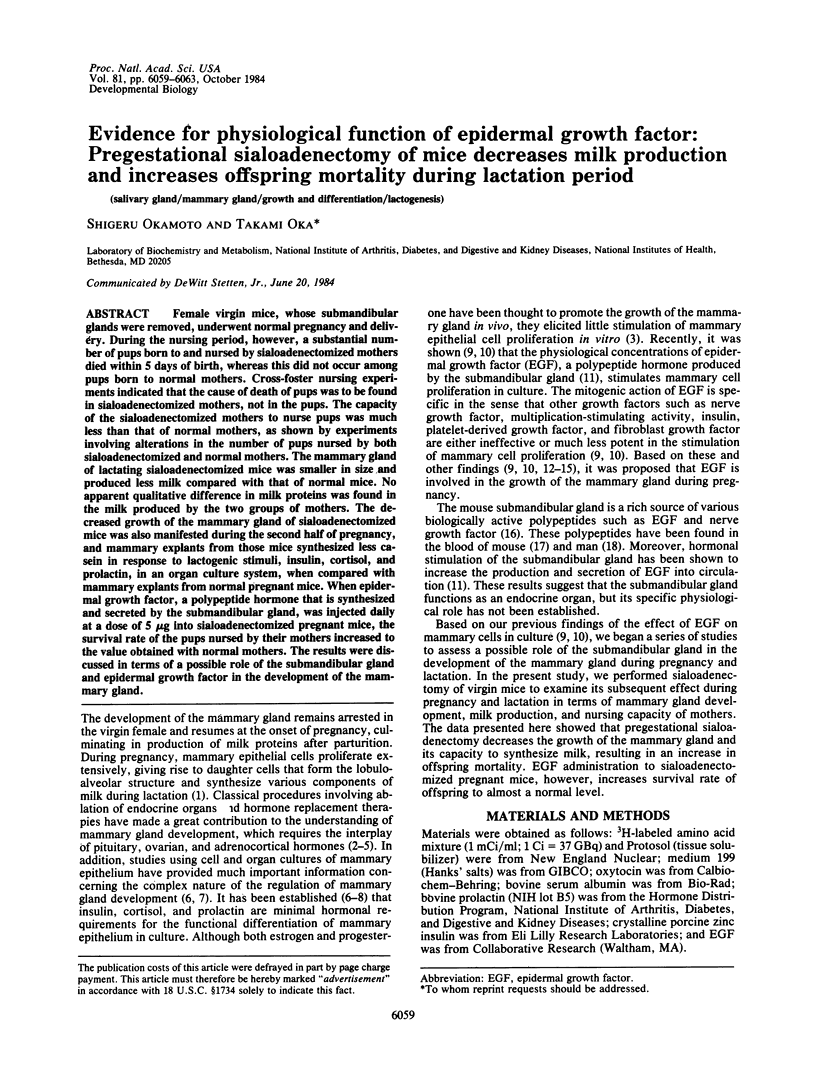
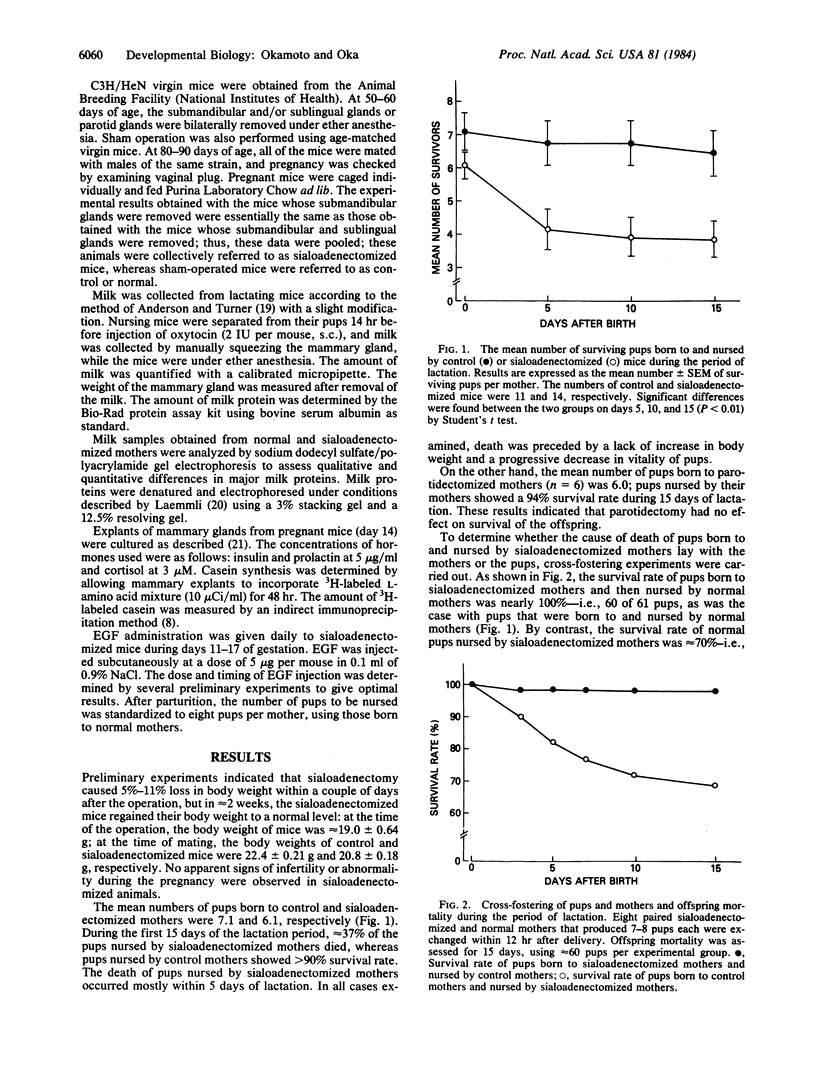
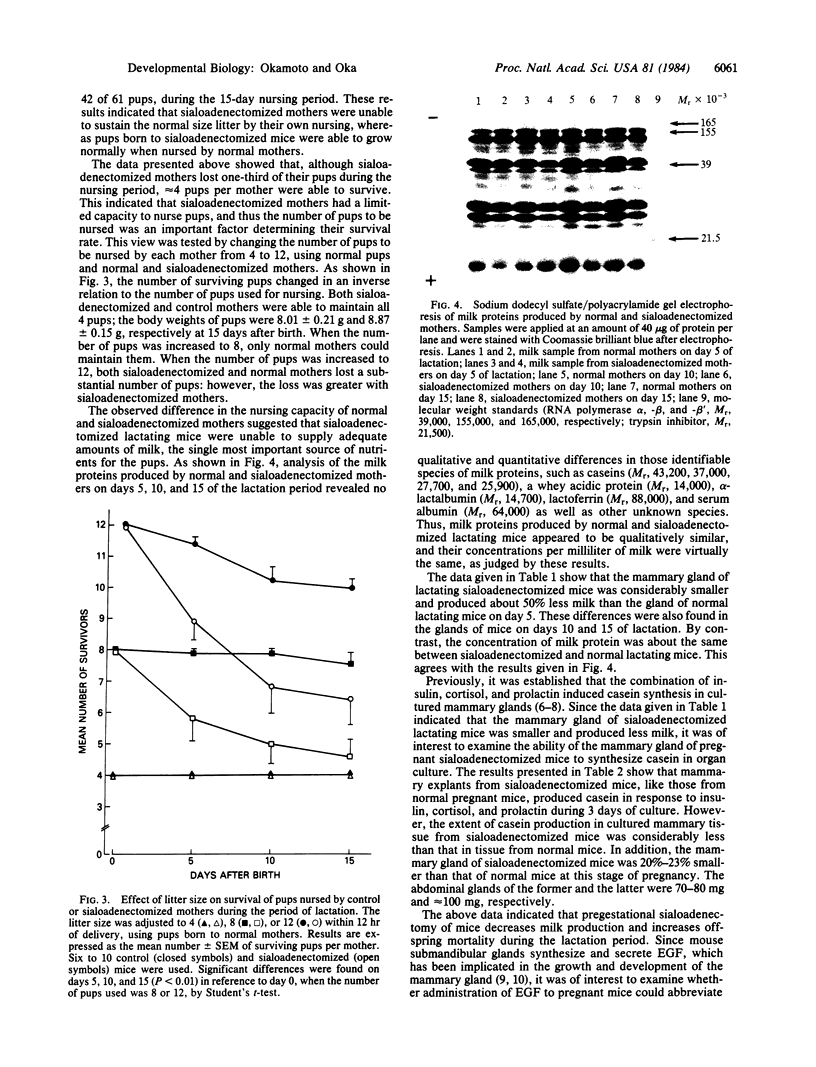
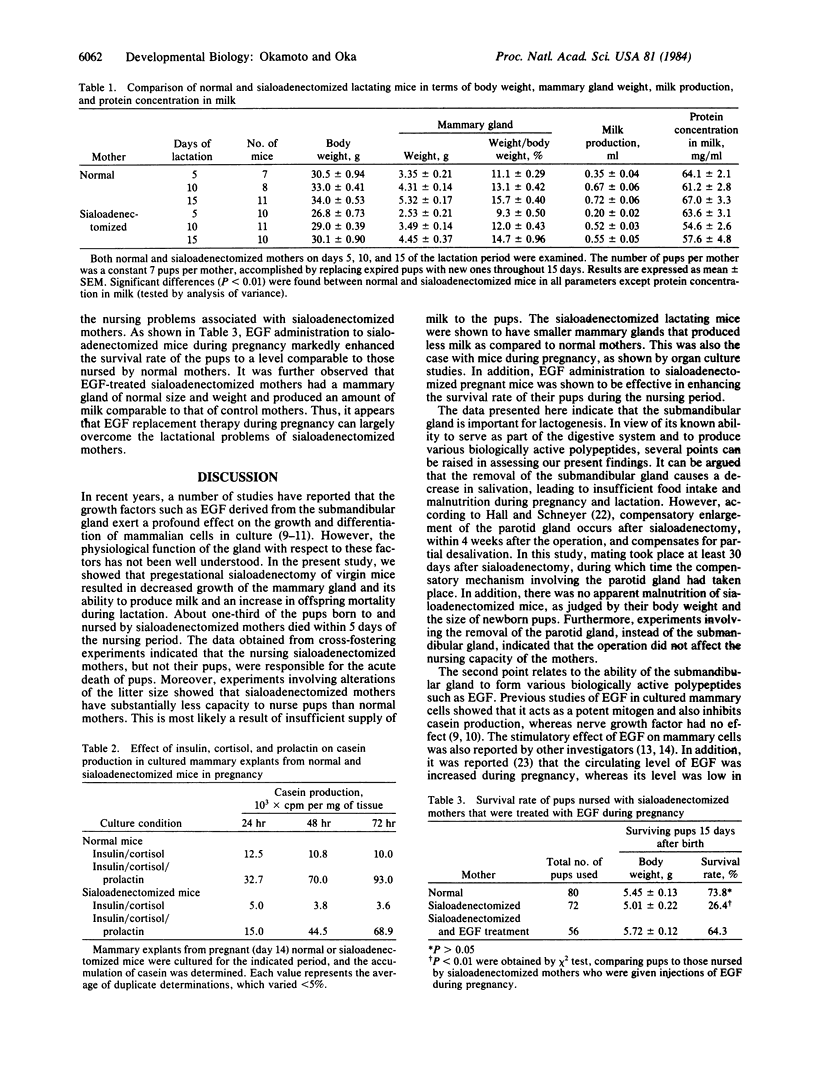
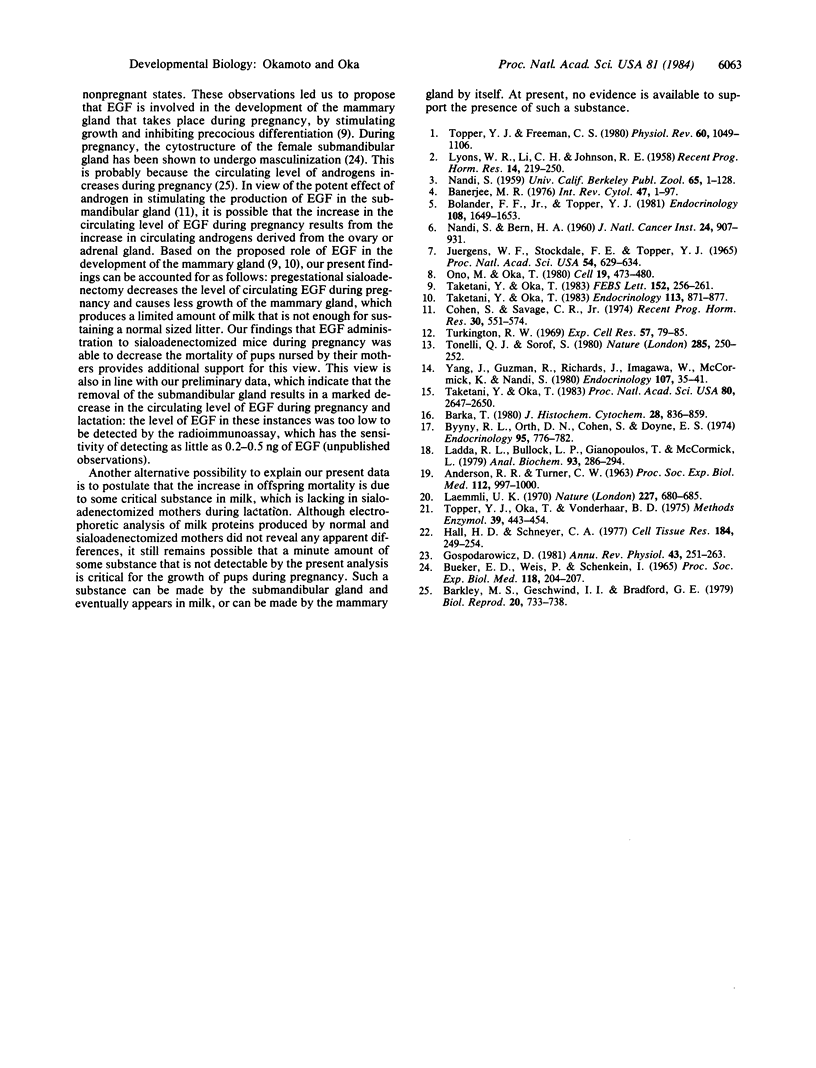
Images in this article
Selected References
These references are in PubMed. This may not be the complete list of references from this article.
- ANDERSON R. R., TURNER C. W. Aldosterone and corticosterone in maintenance of lactation in adrenalectomized rats. Proc Soc Exp Biol Med. 1963 Apr;112:997–1000. doi: 10.3181/00379727-112-28231. [DOI] [PubMed] [Google Scholar]
- BUEKER E. D., WEIS P., SCHENKEIN I. SEXUAL DIMORPHISM OF MOUSE SUBMAXILLARY GLANDS AND ITS RELATIONSHIP TO NERVE GROWTH STIMULATING PROTEIN. Proc Soc Exp Biol Med. 1965 Jan;118:204–207. doi: 10.3181/00379727-118-29798. [DOI] [PubMed] [Google Scholar]
- Banerjee M. R. Responses of mammary cells to hormones. Int Rev Cytol. 1976;47:1–97. doi: 10.1016/s0074-7696(08)60086-8. [DOI] [PubMed] [Google Scholar]
- Barka T. Biologically active polypeptides in submandibular glands. J Histochem Cytochem. 1980 Aug;28(8):836–859. doi: 10.1177/28.8.7003006. [DOI] [PubMed] [Google Scholar]
- Barkley M. S., Geschwind I. I., Bradford G. E. The gestational pattern of estradiol, testosterone and progesterone secretion in selected strains of mice. Biol Reprod. 1979 May;20(4):733–738. doi: 10.1095/biolreprod20.4.733. [DOI] [PubMed] [Google Scholar]
- Bolander F. F., Jr, Topper Y. J. Loss of differentiative potential of the mammary gland in ovariectomized mice: identification of a biochemical lesion. Endocrinology. 1981 May;108(5):1649–1653. doi: 10.1210/endo-108-5-1649. [DOI] [PubMed] [Google Scholar]
- Byyny R. L., Orth D. N., Cohen S., Doyne E. S. Epidermal growth factor: effects of androgens and adrenergic agents. Endocrinology. 1974 Sep;95(3):776–782. doi: 10.1210/endo-95-3-776. [DOI] [PubMed] [Google Scholar]
- Cohen S., Savage C. R., Jr Recent studies on the chemistry and biology of epidermal growth factor. Recent Prog Horm Res. 1974;30(0):551–574. doi: 10.1016/b978-0-12-571130-2.50018-3. [DOI] [PubMed] [Google Scholar]
- Gospodarowicz D. Epidermal and nerve growth factors in mammalian development. Annu Rev Physiol. 1981;43:251–263. doi: 10.1146/annurev.ph.43.030181.001343. [DOI] [PubMed] [Google Scholar]
- Hall H. D., Schneyer C. A. Functional mediation of compensatory enlargement of the parotid gland. Cell Tissue Res. 1977 Oct 26;184(2):249–254. doi: 10.1007/BF00223072. [DOI] [PubMed] [Google Scholar]
- LYONS W. R., LI C. H., JOHNSON R. E. The hormonal control of mammary growth and lactation. Recent Prog Horm Res. 1958;14:219–254. [PubMed] [Google Scholar]
- Ladda R. L., Bullock L. P., Gianopoulos T., McCormick L. Radioreceptor assay for epidermal growth factor. Anal Biochem. 1979 Mar;93(2):286–294. doi: 10.1016/s0003-2697(79)80153-0. [DOI] [PubMed] [Google Scholar]
- Laemmli U. K. Cleavage of structural proteins during the assembly of the head of bacteriophage T4. Nature. 1970 Aug 15;227(5259):680–685. doi: 10.1038/227680a0. [DOI] [PubMed] [Google Scholar]
- NANDI S., BERN H. A. Relation between mammary-gland responses to lactogenic hormone combinations and tumor susceptibility in various strains of mice. J Natl Cancer Inst. 1960 Apr;24:907–931. [PubMed] [Google Scholar]
- Ono M., Oka T. The differential actions of cortisol on the accumulation of alpha-lactalbumin and casein in midpregnant mouse mammary gland in culture. Cell. 1980 Feb;19(2):473–480. doi: 10.1016/0092-8674(80)90522-x. [DOI] [PubMed] [Google Scholar]
- Taketani Y., Oka T. Biological action of epidermal growth factor and its functional receptors in normal mammary epithelial cells. Proc Natl Acad Sci U S A. 1983 May;80(9):2647–2650. doi: 10.1073/pnas.80.9.2647. [DOI] [PMC free article] [PubMed] [Google Scholar]
- Taketani Y., Oka T. Epidermal growth factor stimulates cell proliferation and inhibits functional differentiation of mouse mammary epithelial cells in culture. Endocrinology. 1983 Sep;113(3):871–877. doi: 10.1210/endo-113-3-871. [DOI] [PubMed] [Google Scholar]
- Taketani Y., Oka T. Possible physiological role of epidermal growth factor in the development of the mouse mammary gland during pregnancy. FEBS Lett. 1983 Feb 21;152(2):256–260. doi: 10.1016/0014-5793(83)80391-3. [DOI] [PubMed] [Google Scholar]
- Tonelli Q. J., Sorof S. Epidermal growth factor requirement for development of cultured mammary gland. Nature. 1980 May 22;285(5762):250–252. doi: 10.1038/285250a0. [DOI] [PubMed] [Google Scholar]
- Topper R. J., Oka T., Vonderhaar B. K. Techniques for studying development of normal mammary epithelial cells in organ culture. Methods Enzymol. 1975;39:443–454. doi: 10.1016/s0076-6879(75)39039-3. [DOI] [PubMed] [Google Scholar]
- Topper Y. J., Freeman C. S. Multiple hormone interactions in the developmental biology of the mammary gland. Physiol Rev. 1980 Oct;60(4):1049–1106. doi: 10.1152/physrev.1980.60.4.1049. [DOI] [PubMed] [Google Scholar]
- Turkington R. W. The role of epithelial growth factor in mammary gland development in vitro. Exp Cell Res. 1969 Sep;57(1):79–85. doi: 10.1016/0014-4827(69)90369-3. [DOI] [PubMed] [Google Scholar]
- Yang J., Guzman R., Richards J., Imagawa W., McCormick K., Nandi S. Growth factor- and cyclic nucleotide-induced proliferation of normal and malignant mammary epithelial cells in primary culture. Endocrinology. 1980 Jul;107(1):35–41. doi: 10.1210/endo-107-1-35. [DOI] [PubMed] [Google Scholar]



